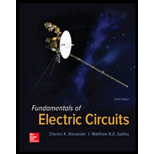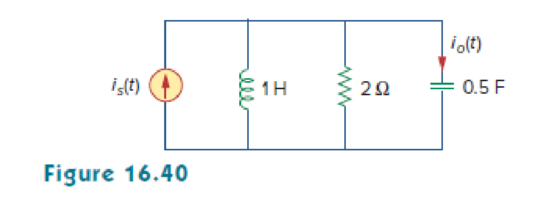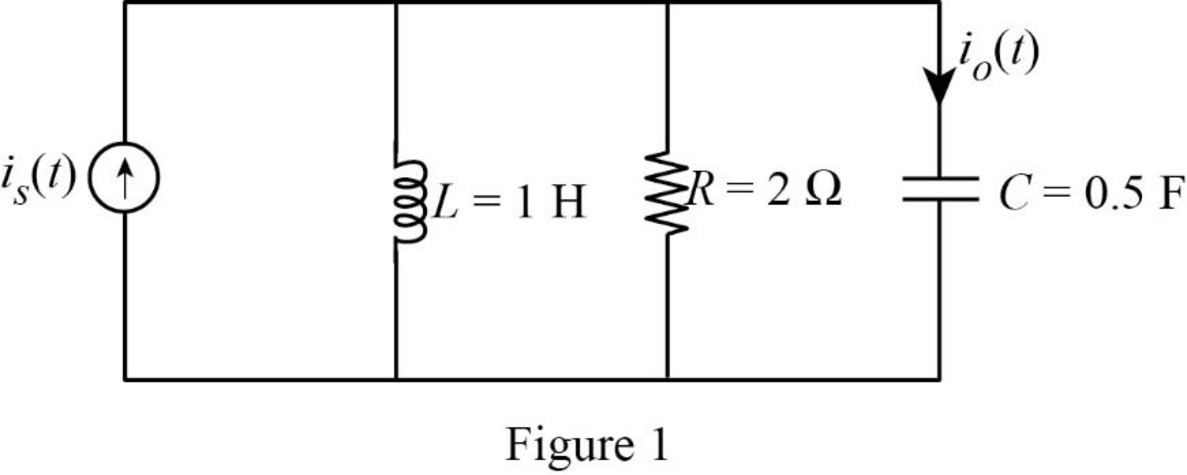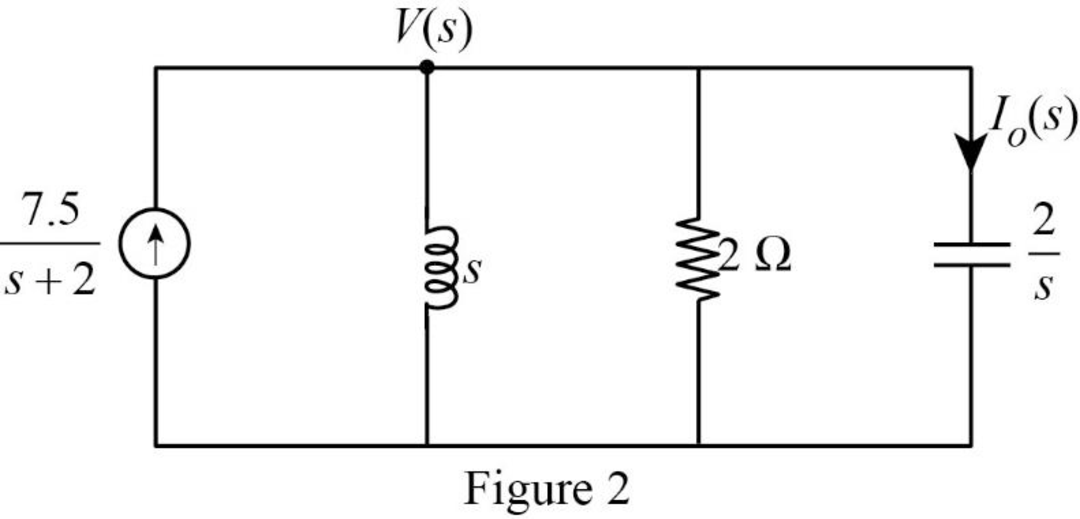
If is(t) = 7.5e–2t u(t) A in the circuit shown in Fig. 16.40, find the value of io(t).

Find the expression of current
Answer to Problem 17P
The expression of current
Explanation of Solution
Given data:
Refer to Figure 16.40 in the textbook.
The value of source current is,
Formula used:
Write a general expression to calculate the impedance of a resistor in s-domain.
Here,
Write a general expression to calculate the impedance of an inductor in s-domain.
Here,
Write a general expression to calculate the impedance of a capacitor in s-domain.
Here,
Calculation:
The given circuit is redrawn as shown in Figure 1.

Substitute
Substitute
Substitute
Apply Laplace transform for equation (1) to find
Convert the Figure 1 into s-domain as shown in Figure 2.

Apply nodal analysis at node
Simplify the above equation to find
From the above equation , the characteristic equation is
Write a general expression to calculate the roots of quadratic equation
Comparing the equation (6) with the equation
Substitute
Simplify the above equation to find
Substitute the roots of characteristic equation in equation (5) to find
Refer to Figure 2, the current through the capacitor is calculated as follows:
Substitute
Take partial fraction for above equation.
The equation (8) can be written as follows:
Simplify the above equation as follows:
Substitute
Simplify the above equation as follows:
Simplify the above equation to find
Substitute
Simplify the above equation to find
Substitute
Simplify the above equation to find
Substitute
Take inverse Laplace transform for above equation to find
Simplify the above equation to find
Simplify the above equation to find
Conclusion:
Thus, the expression of current
Want to see more full solutions like this?
Chapter 16 Solutions
Fundamentals of Electric Circuits
- convert the transfer functions into linear differential equations: a) 1/(1.896s+1) b) 130.19/((s^2)+8.22s+130.19) ..arrow_forwardFind the transfer functions of electrical circuitsarrow_forwardWhich of the following is the H (s) transfer function of the system whose block diagram is given? s / (4s + 3)4 s / (3s + 1)4 s / (3s + 2)s / (s + 4)4 s / (s + 1)3 s / (s + 4)arrow_forward
- The mathematical model of a system is 1y" (t) + 2y' (t) + 1y (t) = 1x' (t) + 2x (t) and the initial conditions are y(0) = 1 and y' (0) = 2. 1) Find the transfer function. 2) Find the system output when the input is Xt) = U(t).arrow_forwardA system whose dynamic equations dx(t)/dt = Ax(t) + Bu(t) y(t) = Cx(t) are given as . Find the eigenvalues of A. Find the transfer relationship between X(s) and U(s). Find the Y (s)/ U(s) transfer function.arrow_forwardExplain the following: 1) LTI Systems2) Frequency response of LTI Systems 3) LTI System Eigen-function and Eigen-valuearrow_forward
- Draw or plot the response of the Second Order System for the different transfer functions of signals.arrow_forwardfor H(s) = (s + 1)/(s + 4)2 find the system response to the input u(t) aka the unit step functionarrow_forwardA system is described by the differential equation (see attached). a)What is the order of the system. How many poles does the system's transfer function have. How many states are needed to describe the system completely.b) Determine the system's transfer function, Y(s)/U(s) (the poles of the system are at ―1, ― 2, and ―4);c) Determine matrices A, B, C, and D to describe the system in state-space form x' = Ax + Bu, y = Cx + Du.arrow_forward
- Find the transfer function, G(s) = θ2 (s) / T (s), for the following rotational mechanical system with gearsarrow_forwardCircuit analysis 2 Which of the following is the derivative of the function given below equal to?arrow_forwardIf the transfer function V2(s) / V1(s) = s / s^2+5s+4, then find the Z. (It may contain R,L,C components). ..arrow_forward
 Introductory Circuit Analysis (13th Edition)Electrical EngineeringISBN:9780133923605Author:Robert L. BoylestadPublisher:PEARSON
Introductory Circuit Analysis (13th Edition)Electrical EngineeringISBN:9780133923605Author:Robert L. BoylestadPublisher:PEARSON Delmar's Standard Textbook Of ElectricityElectrical EngineeringISBN:9781337900348Author:Stephen L. HermanPublisher:Cengage Learning
Delmar's Standard Textbook Of ElectricityElectrical EngineeringISBN:9781337900348Author:Stephen L. HermanPublisher:Cengage Learning Programmable Logic ControllersElectrical EngineeringISBN:9780073373843Author:Frank D. PetruzellaPublisher:McGraw-Hill Education
Programmable Logic ControllersElectrical EngineeringISBN:9780073373843Author:Frank D. PetruzellaPublisher:McGraw-Hill Education Fundamentals of Electric CircuitsElectrical EngineeringISBN:9780078028229Author:Charles K Alexander, Matthew SadikuPublisher:McGraw-Hill Education
Fundamentals of Electric CircuitsElectrical EngineeringISBN:9780078028229Author:Charles K Alexander, Matthew SadikuPublisher:McGraw-Hill Education Electric Circuits. (11th Edition)Electrical EngineeringISBN:9780134746968Author:James W. Nilsson, Susan RiedelPublisher:PEARSON
Electric Circuits. (11th Edition)Electrical EngineeringISBN:9780134746968Author:James W. Nilsson, Susan RiedelPublisher:PEARSON Engineering ElectromagneticsElectrical EngineeringISBN:9780078028151Author:Hayt, William H. (william Hart), Jr, BUCK, John A.Publisher:Mcgraw-hill Education,
Engineering ElectromagneticsElectrical EngineeringISBN:9780078028151Author:Hayt, William H. (william Hart), Jr, BUCK, John A.Publisher:Mcgraw-hill Education,





